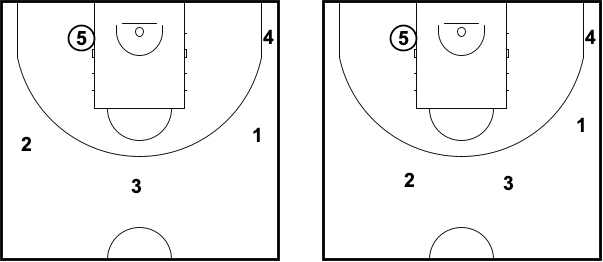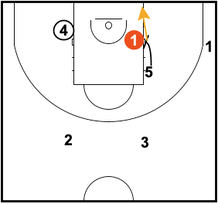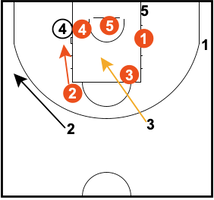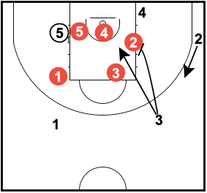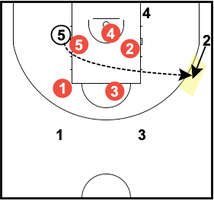The Operating System
Post MOBility - static spacing
Written by coach Thomas Roijakkers
Operating System
Before I start talking about POST MOBility I have to mention the Operating System. Like with a computer the OS is the brain of your offensive system and therefor making it the most important offensive system of a team. The OS enables a team to get the best result every offensive possession.
It contains the rules and guidelines on how to execute the offense. From experience I prefer to speak about guidelines more than rules, because there is no absolute in basketball and different situations can have different solutions. In certain situations you can simplify by using rules and in other situations you can give the players more freedom.
The rules and guidelines should involve
Although a big part of the OS is set, you can and should adjust your OS to your team and the skills / strengths of your players.
When having a good functioning OS your players will be on the same page. This will give you a lot of advantages like:
The offensive sets of a team are like the apps on your computer or phone. When they are run they break down into the OS.
My OS contains out of seven parts, which one of them is Post MOBility. I constantly update/change this system and am always looking for improvements to give my team an edge.
Now that I have explained the OS let’s look into the Post MOBility.
POST MOBility
Post MOBillity is one of the seven parts of the OS. Post MOB stands for Post Movement Off the Ball. Others may call this post offense or post automatics. Post MOBility are the actions we use when the ball goes into the low post.
In general there are two types of spacing:
I prefer to use the dynamic spacing in combination with scoring options for the players off the ball. There are also coaches that use more of a static like spacing. Both can work, but for several reasons, more movement and more options being some of them, I like the dynamic spacing a lot more. The times I do use the more static like spacing is when we have an early mismatch, a clear mismatch in the post or on a deep post touch.
When you want to create an option in the low post you can use several players (also a guard) to start the action. Depending on the option you want to create you can use a dominant scorer in the low post, but also a “non” scoring player can give you great options. In the last case he will be used more as a passer than scorer.
Static spacing
Before I start talking about spacing I want to mention that I don’t mean that the players off the ball are static during the entire possession. Once the ball goes into the post they move to certain spots or areas while spacing the floor and then become more static as they let the ball handler create. Then depending on position/vision of the defense they might cut, move or stay spaced.
This can be done with a 4 out 1 in spacing, usually when the 5 is posting up, or a 3 out 2 in line up, usually when posting up a perimeter player 1 - 4 and your 5 is a non-shooter.
Locations
After the ball goes into the low post the spots that will be filled are:
1 in 4 out: 45, top, 45, corner OR slot, slot, 45, corner.
2 in 3 out: 5 to dead low, slot, slot, break.
The players at the 45’s, top and slots are located on the 4 point line for even more spacing.
Operating System
Before I start talking about POST MOBility I have to mention the Operating System. Like with a computer the OS is the brain of your offensive system and therefor making it the most important offensive system of a team. The OS enables a team to get the best result every offensive possession.
It contains the rules and guidelines on how to execute the offense. From experience I prefer to speak about guidelines more than rules, because there is no absolute in basketball and different situations can have different solutions. In certain situations you can simplify by using rules and in other situations you can give the players more freedom.
The rules and guidelines should involve
- Spacing (spots or areas)
- Movement Off the Ball (cutting, screening, spotting up)
- Shot selection
- Decision making
Although a big part of the OS is set, you can and should adjust your OS to your team and the skills / strengths of your players.
When having a good functioning OS your players will be on the same page. This will give you a lot of advantages like:
- Players know what to look for and what to do
- Therefor can make quicker decisions
- Better timing
- Less mistakes
- Offense runs quicker and keeps better flow
- Not just reacting on the defense, but acting within the offense
- Resulting in a more effective offense.
The offensive sets of a team are like the apps on your computer or phone. When they are run they break down into the OS.
My OS contains out of seven parts, which one of them is Post MOBility. I constantly update/change this system and am always looking for improvements to give my team an edge.
Now that I have explained the OS let’s look into the Post MOBility.
POST MOBility
Post MOBillity is one of the seven parts of the OS. Post MOB stands for Post Movement Off the Ball. Others may call this post offense or post automatics. Post MOBility are the actions we use when the ball goes into the low post.
In general there are two types of spacing:
- Static like spacing
- Dynamic spacing
I prefer to use the dynamic spacing in combination with scoring options for the players off the ball. There are also coaches that use more of a static like spacing. Both can work, but for several reasons, more movement and more options being some of them, I like the dynamic spacing a lot more. The times I do use the more static like spacing is when we have an early mismatch, a clear mismatch in the post or on a deep post touch.
When you want to create an option in the low post you can use several players (also a guard) to start the action. Depending on the option you want to create you can use a dominant scorer in the low post, but also a “non” scoring player can give you great options. In the last case he will be used more as a passer than scorer.
Static spacing
Before I start talking about spacing I want to mention that I don’t mean that the players off the ball are static during the entire possession. Once the ball goes into the post they move to certain spots or areas while spacing the floor and then become more static as they let the ball handler create. Then depending on position/vision of the defense they might cut, move or stay spaced.
This can be done with a 4 out 1 in spacing, usually when the 5 is posting up, or a 3 out 2 in line up, usually when posting up a perimeter player 1 - 4 and your 5 is a non-shooter.
Locations
After the ball goes into the low post the spots that will be filled are:
1 in 4 out: 45, top, 45, corner OR slot, slot, 45, corner.
2 in 3 out: 5 to dead low, slot, slot, break.
The players at the 45’s, top and slots are located on the 4 point line for even more spacing.
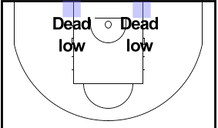
Two bigs
When playing with two bigs inside, the opposite big will position himself in the dead low.
The dead low position is the blue area on the baseline. The advantage of being in the dead low instead of the block is that his defender:
The opposite big can simply move to the dead low or he can set a screen to open up a weak side shooter.
When playing with two bigs inside, the opposite big will position himself in the dead low.
The dead low position is the blue area on the baseline. The advantage of being in the dead low instead of the block is that his defender:
- needs to position himself lower to be able to see both the ball and his man, which makes it more difficult to help OR
- when staying “higher” the defense needs to turn his head to see him, which at that moment he doesn’t see the man with the ball.
The opposite big can simply move to the dead low or he can set a screen to open up a weak side shooter.
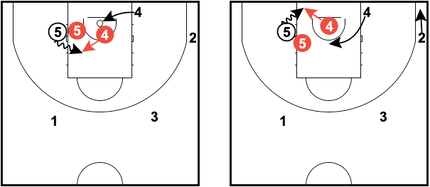
The interaction between the two bigs is as following:
Cutting and relocating
The players on the outside can be “static” for a moment, but because spacing is
always alive it can change at any moment. That is why it is important that they stay ready to:
Cutting can be done from any position on the floor and requires good timing, speed and intention (cut to score/screen). A good moment to cut is when your defender is ball watching (back door cut) or he is out of position (front/back door cut). You can cut to score or cut to screen to get somebody else open. Also you can have players cut from a certain position or have designated cutters and shooters which is more personnel based.
- middle drive = circle under
- baseline drive = circle up
Cutting and relocating
The players on the outside can be “static” for a moment, but because spacing is
always alive it can change at any moment. That is why it is important that they stay ready to:
- cut (score/screen)
- relocate (find a window)
- stay spaced (catch + shoot)
Cutting can be done from any position on the floor and requires good timing, speed and intention (cut to score/screen). A good moment to cut is when your defender is ball watching (back door cut) or he is out of position (front/back door cut). You can cut to score or cut to screen to get somebody else open. Also you can have players cut from a certain position or have designated cutters and shooters which is more personnel based.
Relocating can involve one or more players. An example of a one player relocate action can be moving from the slot to the 45 or corner (off 2) when his defender drops and digs in the post.
A cut to score/screen and lift action, which can open up a shooter, is an example where two players are involved. It is even possible to have two players cut at the same time, but that is not my preference since the spacing isn’t as good as compared to 1 cutter.
A cut to score/screen and lift action, which can open up a shooter, is an example where two players are involved. It is even possible to have two players cut at the same time, but that is not my preference since the spacing isn’t as good as compared to 1 cutter.
For the players on the weakside it is important that they find a window. This means that they need to get in the vision on the ball handler and give him the opportunity for a kick out. The rule I use here is: the ball must see you! Not to be mistaken with: you must see the ball.
This goes for a both a drive to the middle (window 45 area) and a baseline drive (corner fill). Important is that there cannot be three in a row, meaning the shooter cannot “hide” behind another player off the ball.
This concludes my article about the static spacing of the POST Mobility. In the next article I will talk about the dynamic spacing of the Post MOBility.
Click here to watch the video of this article.
Coach Thomas Roijakkers
This goes for a both a drive to the middle (window 45 area) and a baseline drive (corner fill). Important is that there cannot be three in a row, meaning the shooter cannot “hide” behind another player off the ball.
This concludes my article about the static spacing of the POST Mobility. In the next article I will talk about the dynamic spacing of the Post MOBility.
Click here to watch the video of this article.
Coach Thomas Roijakkers
